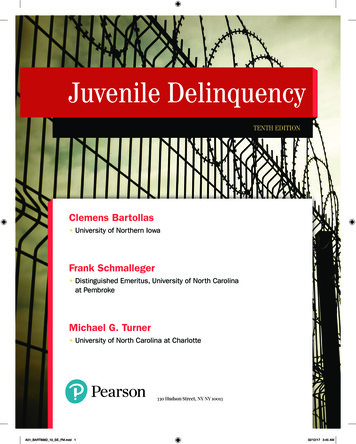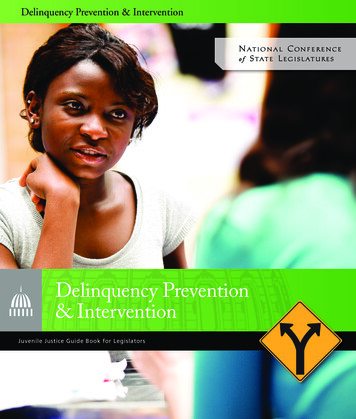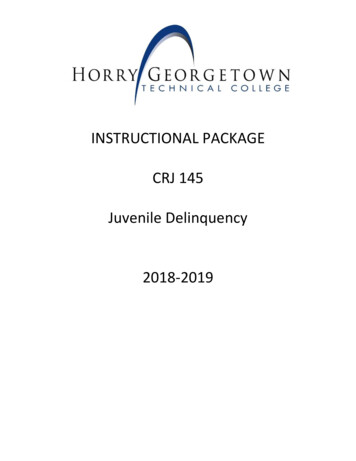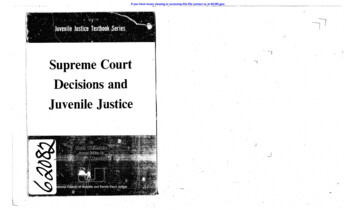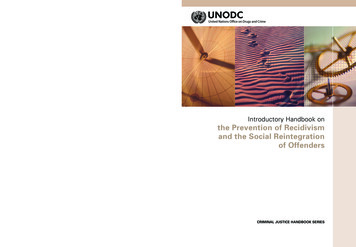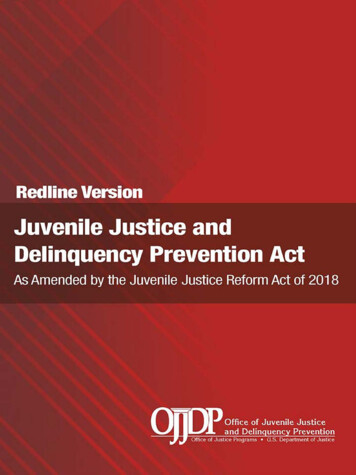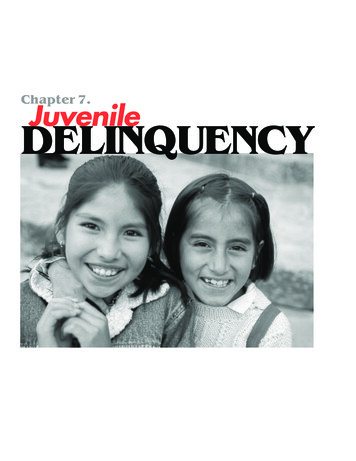
Transcription
Chapter 7.JuvenileDELINQUENCY
Delinquent and criminal behaviouramongyoung people, as they negotiate the transition from childhood toadulthood in an increasingly complex and confusing world, is theissue that this chapter first examines. Some basic assumptionsrelating to delinquent behaviour are presented, followed by adescription of the various factors underlying or contributing to thisphenomenon. Some regional variations are highlighted. Effectiveapproaches and measures for preventing juvenile delinquencyare detailed, with particular attention given to the development ofeducational, professional development and community programmes,improvements in family relations and parenting skills, and the valueof restorative justice for both perpetrators and victims. The chapterconcludes with a summary and recommendations for future action.INTRODUCTIONFor many young people today, traditional patterns guiding the relationships and transitions between family, school and work are being challenged. Social relations thatensure a smooth process of socialization are collapsing; lifestyle trajectories arebecoming more varied and less predictable. The restructuring of the labour market,the extension of the maturity gap (the period of dependence of young adults on thefamily) and, arguably, the more limited opportunities to become an independent adultare all changes influencing relationships with family and friends, educational opportunities and choices, labour market participation, leisure activities and lifestyles. It is notonly developed countries that are facing this situation; in developing countries as wellthere are new pressures on young people undergoing the transition from childhood toindependence. Rapid population growth, the unavailability of housing and supportservices, poverty, unemployment and underemployment among youth, the decline inthe authority of local communities, overcrowding in poor urban areas, the disintegration of the family, and ineffective educational systems are some of the pressuresyoung people must deal with.Youth nowadays, regardless of gender, social origin or country of residence,are subject to individual risks but are also being presented with new individual opportunities—some beneficial and some potentially harmful. Quite often, advantage isbeing taken of illegal opportunities as young people commit various offences, becomeaddicted to drugs, and use violence against their peers.Statistical data indicate that in virtually all parts of the world, with the exception of the United States, rates of youth crime rose in the 1990s. In Western Europe,one of the few regions for which data are available, arrests of juvenile delinquents andunder-age offenders increased by an average of around 50 per cent between the mid1980s and the late 1990s. The countries in transition have also witnessed a dramaticrise in delinquency rates; since 1995, juvenile crime levels in many countries inEastern Europe and the Commonwealth of Independent States have increased bymore than 30 per cent. Many of the criminal offences are related to drug abuse andexcessive alcohol use.Juvenile Delinquency World YOUTH Report, 2003189
The majority of studies and programmes dealing with juvenile delinquencyfocus on youth as offenders. However, adolescents are also victims of criminal ordelinquent acts. The continuous threat of victimization is having a serious impact onthe socialization of young men and on their internalization of the norms and values ofthe larger society. According to data on crimes registered by the police, more than 80per cent of all violent incidents are not reported by the victims. Information about thevictims allows conclusions to be drawn about the offenders as well. Results of selfreport studies indicate that an overwhelming majority of those who participate in violence against young people are about the same age and gender as their victims; inmost cases the offenders are males acting in groups.1 Those most likely to be on thereceiving end of violence are between the ages of 16 and 19, with 91 in every 1,000in this group becoming victims of some form of crime. Surveys have shown that menare more likely than women to become victims. In the United States, 105 in every1,000 men become crime victims, compared with 80 per 1,000 women. Men are 2.5times more likely to be victims of aggravated assault. Older people are less oftenaffected; as mentioned, crimes are usually committed by representatives of the sameage groups to which the victims belong.Young people who are at risk of becoming delinquent often live in difficult circumstances.2 Children who for various reasons—including parental alcoholism, poverty, breakdown of the family, overcrowding, abusive conditions in the home, the growing HIV/AIDS scourge, or the death of parents during armed conflicts—are orphans orunaccompanied and are without the means of subsistence, housing and other basicnecessities are at greatest risk of falling into juvenile delinquency. The number of children in especially difficult circumstances is estimated to have increased from 80 million to 150 million between 1992 and 2000.3The problem of juvenile delinquency is becoming more complicated and universal, and crime prevention programmes are either unequipped to deal with the present realities or do not exist. Many developing countries have done little or nothing todeal with these problems, and international programmes are obviously insufficient.Developed countries are engaged in activities aimed at juvenile crime prevention, butthe overall effect of these programmes is rather weak because the mechanisms inplace are often inadequate to address the existing situation.On the whole, current efforts to fight juvenile delinquency are characterizedby the lack of systematic action and the absence of task-oriented and effective socialwork with both offenders and victims, whether real or potential. Analysis is furthercomplicated by a lack of international comparative data.BASIC ASSUMPTIONSOF DELINQUENTBEHAVIOURIt is impossible to develop effective prevention programmes without understandingthe reasons behind juvenile involvement in criminal activity. Different approaches areused in scientific and practical literature on juvenile crime and violence to define andexplain delinquent behaviour by young people. To criminologists, juvenile delinquencyencompasses all public wrongs committed by young people between the ages of 12190
and 20. Sociologists view the concept more broadly, believing that it covers a multitude of different violations of legal and social norms, from minor offences to seriouscrimes, committed by juveniles. Included under the umbrella of juvenile delinquencyare status offences, so called because they are closely connected with the age statusof an offender; a particular action or behaviour is considered a violation of the law onlyif it is committed by a juvenile (examples include truancy and running away). In anattempt to explain the theoretical underpinnings of delinquency, sociologists associate the specifics of youth behaviour with the home, family, neighbourhood, peers andmany other variables that together or separately influence the formation of young people’s social environment.Antisocial behaviour may be a normal part of growing up or the beginning ofa long-term pattern of criminal activity. The United Nations Guidelines for thePrevention of Juvenile Delinquency (the Riyadh Guidelines) assert that “youthfulbehaviour or conduct that does not conform to overall social norms and values isoften part of the maturation and growth process and tends to disappear spontaneouslyin most individuals with the transition to adulthood”; a great majority of young peoplecommit some kind of petty offence at some point during their adolescence withoutthis turning into a criminal career in the long term.4 While delinquency is a commoncharacteristic of the period and process of becoming an adult, it is very important tonote that juveniles often create stable criminal groups with a corresponding subculture and start to engage in the activities of adult criminal groups, in effect choosingdelinquent careers.Statistical data in many countries show that delinquency is largely a group phenomenon; between two-thirds and three-quarters of all juvenile offences are committed by members of various groups. Even those juveniles who commit offences aloneare likely to be associated with groups. According to data from the Russian Federation,the rate of criminal activity among juveniles in groups is about three to four times higher than that of adult offenders. Juvenile group crime is most prevalent among 14-yearolds and least prevalent among 17-year-olds. The rates are higher for theft, robberyand rape, and lower for premeditated murder and grievous bodily harm.Similarities in the basic characteristics of juvenile group behaviour are foundin almost every class and cultural context. Juvenile peer groups are noted for theirhigh levels of social cohesiveness, hierarchical organization, and a certain code ofbehaviour based on the rejection of adult values and experience. The subculturalaspect of juvenile group activities is rarely given the attention it deserves. Differentjuvenile groups adopt what amounts to a heterogeneous mix, or synthesis, of predominant (class-based) values, which are spread by the entertainment industry, andintergenerational (group-based) values, which are native to the family or neighbourhood. Subcultures can be defined as particular lifestyle systems that are developed ingroups and are in structurally subordinate positions as a result of pressure exerted bythe predominant systems.Subcultures reflect individual and group attempts to solve structural contradictions. One of the most important aspects of subcultures is that they form patternsof behaviour that have substantial symbolic value for the individuals involved. At present there are various subcultures in which deviant behaviour and violence play anJuvenile Delinquency World YOUTH Report, 2003191
important role. Some groups and subcultures tend to use violence as a means of solving interpersonal conflicts, and the atmosphere thus created is an important mediating factor contributing to delinquent or criminal behaviour. This might even be referredto as a subculture of violence, in which aggression is considered an acceptable andeven preferable and courageous approach to problem-solving.Those most likely to participate in delinquent activities are members of territorial gangs. According to statistical evidence, they commit three times as manycrimes as juveniles and youths who are not gang members. Studies reveal that themost frequent offences committed by gang members are fighting, street extortionand school violence.The fact that juvenile groups always exist in local communities must be takeninto consideration. A community is defined by the similar social characteristics of itsresidents, such as membership in a social class or ethnic group. Urban neighbourhoodcommunities provide their members with a certain everyday social comfort at the locallevel. Under conditions of social diversity and urban growth these neighbourhoodunits, like rural communities, are able to balance the social interests of the groupsthey contain.Membership in juvenile groups is sometimes an essential element of socialization. Several studies have shown the possibility of establishing connectionsbetween delinquent groups and other social institutions—a “symbiosis” in whichgangs can, for instance, work to satisfy any of a community’s needs.5 As mentionedearlier, in many cases juvenile delinquent groups are also the entry point to adultorganized crime.Available data show that delinquency and crime have strong gender associations. Police records indicate that the crime rates of male juvenile and male youngadult offenders are more than double those of young females, and conviction rates aresix or seven times higher. The number of male juvenile suspects for every 100,000members of the designated age group is more than six times the corresponding figurefor females; for those in the youth category the male-female suspect ratio is even higher, at 12.5 to 1.6 There are a number of reasons why more young men than youngwomen are involved in violent or criminal behaviour. Various restrictive and stimulative factors encourage women to conform to social norms that do not apply to men,one example being the fear of sexual assault. Girls are subject to stronger family control than are boys. Cultural concepts are such that society at large is less tolerant ofdeviant behaviour among young women than among young men. In addition, aggression and violence play an important role in the construction of masculinity and sexuality in patriarchal societies, the primary objective being to reinforce and maintain thestatus and authoritative position of men. The male perception of violence can be minimized, forgiven, denied or justified. Men often do not consider such acts as verbal orsexual insults7 to constitute violent behaviour.There are cultures in which the dominant type of masculinity is more or lessopenly directed towards violent confrontation, domination and control.8 In other cultures the socialization of young males towards hegemonic masculinity is not attached192
to norms of physical prowess, hard work and a readiness to fight. For both boys andgirls, the street gang is an ideal context for “doing gender” (establishing gender differences). Consequently, girls who are gang members are not simply passive recipientsof “patriarchy” but active participants in the construction of gender relations.The peer group plays an important part in the construction of gender rolesand relations, including delinquent behaviour. Youth gangs reflect the gender-basedpower relations in society and the related discourse and practices by which they arereproduced. Consequently, differences in male and female behaviour in this contextare partly a product of the social construction of gendered dominance and subordination in gang arrangements.CAUSES OF AND CONDITIONS FOR THEFORMATION OF DELINQUENT TRAJECTORIESThe intensity and severity of juvenile offences are generally determined by the social,economic and cultural conditions prevailing in a country. There is evidence of a universal increase in juvenile crime taking place concurrently with economic decline,especially in the poor districts of large cities. In many cases street children laterbecome young offenders, having already encountered violence in their immediatesocial environment as either witnesses or victims of violent acts. The educationalattainments of this group are rather low as a rule, basic social experience acquired inthe family is too often insufficient, and the socio-economic environment is determinedby poverty and under- or unemployment.9The causes of and conditions for juvenile crime are usually found at each levelof the social structure, including society as a whole, social institutions, social groupsand organizations, and interpersonal relations. Juveniles’ choice of delinquent careersand the consequent perpetuation of delinquency are fostered by a wide range of factors, the most important of which are described below.Economic and social factorsJuvenile delinquency is driven by the negative consequences of social andeconomic development, in particular economic crises, political instability, and theweakening of major institutions (including the State, systems of public education andpublic assistance, and the family). Socio-economic instability is often linked to persistent unemployment and low incomes among the young, which can increase the likelihood of their involvement in criminal activity.Cultural factorsDelinquent behaviour often occurs in social settings in which the norms foracceptable behaviour have broken down. Under such circumstances many of thecommon rules that deter people from committing socially unacceptable acts maylose their relevance for some members of society. They respond to the traumatizingand destructive changes in the social reality by engaging in rebellious, deviant oreven criminal activities. An example of such a setting would be the modernization oftraditional societies and the accompanying changes wrought by the application ofJuvenile Delinquency World YOUTH Report, 2003193
new technologies; shifts of this magnitude affect the types and organization of labouractivity, social characteristics, lifestyles and living arrangements, and these changes,in turn, affect authority structures, forms of obedience, and modes of political participation—even going so far as to influence perceptions of reality.In both developed and developing countries, consumer standards created bythe media are considerably beyond the capacity of most families to achieve.Nevertheless, these ideals become a virtual reality for many young people, some ofwhom will go to great lengths to maintain a lifestyle they cannot afford. Because notall population groups have access to the necessary resources, including education,professional training, satisfactory employment and income, health services, andadequate housing, there are those who are unable to achieve their goals by legalmeans. The contradiction between idealized and socially approved goals and thesometimes limited real-life opportunities to achieve them legally creates a sense offrustration in many young people. A criminal career becomes one form of addressing this contradiction. One of the reasons for delinquent behaviour is therefore anexcessive focus on proposed goals (achieving success) coupled with insufficientmeans to achieve them.The likelihood of deviant acts occurring in this context depends in manyrespects not only on the unavailability of legal opportunities but also on the level ofaccess to illegal opportunities. Some juveniles, cognizant of the limitations imposedby legal behaviour, come under the influence of adult criminals. Many young peopleretreat into the confines of their own groups and resort to drug use for psychologicalor emotional escape. The use of alcohol and illegal drugs by juveniles is one cause ofdelinquency, as they are often compelled to commit crimes (usually theft) to obtainthe cash needed to support their substance use.UrbanizationGeographical analysis suggests that countries with more urbanized populations have higher registered crime rates than do those with strong rural lifestyles andcommunities. This may be attributable to the differences in social control and socialcohesion. Rural groupings rely mainly on family and community control as a means ofdealing with antisocial behaviour and exhibit markedly lower crime rates. Urban industrialized societies tend to resort to formal legal and judicial measures, an impersonalapproach that appears to be linked to higher crime rates. Cultural and institutionaldifferences are such that responses to the same offence may vary widely from onecountry to another.The ongoing process of urbanization in developing countries is contributing tojuvenile involvement in criminal behaviour. The basic features of the urban environment foster the development of new forms of social behaviour deriving mainly fromthe weakening of primary social relations and control, increasing reliance on the mediaat the expense of informal communication, and the tendency towards anonymity.These patterns are generated by the higher population density, degree of heterogeneity, and numbers of people found in urban contexts.194
Studies show that children who receive adequate parental supervision are lesslikely to engage in criminal activities. Dysfunctional family settings—characterized byconflict, inadequate parental control, weak internal linkages and integration, and premature autonomy—are closely associated with juvenile delinquency. Children in disadvantaged families that have few opportunities for legitimate employment and face ahigher risk of social exclusion are overrepresented among offenders. The plight of ethnic minorities and migrants, including displaced persons and refugees in certain partsof the world, is especially distressing. The countries in transition are facing particularchallenges in this respect, with the associated insecurity and turmoil contributing to anincrease in the numbers of children and juveniles neglected by their parents and suffering abuse and violence at home.FamilyThe family as a social institution is currently undergoing substantial changes;its form is diversifying with, for example, the increase in one-parent families and nonmarital unions. The absence of fathers in many low-income families can lead boys toseek patterns of masculinity in delinquent groups of peers. These groups in manyrespects substitute for the family, define male roles, and contribute to the acquisitionof such attributes as cruelty, strength, excitability and anxiety.The importance of family well-being is becoming increasingly recognized.Success in school depends greatly on whether parents have the capacity to providetheir children with “starting” opportunities (including the resources to buy books andmanuals and pay for studies). Adolescents from low-income families often feel excluded. To raise their self-esteem and improve their status they may choose to join a juvenile delinquent group. These groups provide equal opportunities to everyone,favourably distinguishing themselves from school and family, where positions ofauthority are occupied by adults.When young people are exposed to the influence of adult offenders they havethe opportunity to study delinquent behaviour, and the possibility of their engaging inadult crime becomes more real. The “criminalization” of the family also has an impacton the choice of delinquent trajectories. A study carried out in prisons in the UnitedStates reveals that families involved in criminal activities tend to push their youngermembers towards violating the law. More than two-thirds of those interviewed had relatives who were incarcerated; for 25 per cent it was a father and for another 25 percent a brother or sister.Because immigrants often exist in the margins of society and the economy andhave little chance of success in the framework of the existing legal order, they oftenseek comfort in their own environment and culture. Differences in norms and valuesand the varying degrees of acceptability of some acts in different ethnic subculturesresult in cultural conflicts, which are one of the main sources of criminal behaviour.Native urban populations tend to perceive immigrants as obvious deviants.MigrationJuvenile Delinquency World YOUTH Report, 2003195
The mediaExclusionTelevision and movies have popularized the “cult of heroes”, which promotesjustice through the physical elimination of enemies. Many researchers have concluded that young people who watch violence tend to behave more aggressively or violently, particularly when provoked. This is mainly characteristic of 8- to 12-year-oldboys, who are more vulnerable to such influences. Media bring an individual to violence in three ways. First, movies that demonstrate violent acts excite spectators, andthe aggressive energy can then be transferred to everyday life, pushing an individualto engage in physical activity on the streets. This type of influence is temporary, lasting from several hours to several days. Second, television can portray ordinary dailyviolence committed by parents or peers (the imposition of penalties for failing to studyor for violations of certain rules or norms of conduct). It is impossible to find television shows that do not portray such patterns of violence, because viewer approval ofthis type of programming has ensured its perpetuation. As a result, children are continually exposed to the use of violence in different situations—and the number of violent acts on television appears to be increasing. Third, violence depicted in the mediais unreal and has a surrealistic quality; wounds bleed less, and the real pain and agonyresulting from violent actions are very rarely shown, so the consequences of violentbehaviour often seem negligible. Over time, television causes a shift in the system ofhuman values and indirectly leads children to view violence as a desirable and evencourageous way of reestablishing justice. The American Psychological Association hasreviewed the evidence and has concluded that television violence accounts for about10 per cent of aggressive behaviour among children.10The growing gap between rich and poor has led to the emergence of “unwanted others”. The exclusion of some people is gradually increasing with the accumulation of obstacles, ruptured social ties, unemployment and identity crises. Welfare systems that have provided relief but have not eliminated the humble socio-economicposition of certain groups, together with the increased dependence of low-income families on social security services, have contributed to the development of a “new poor”class in many places.The symbolic exclusion from society of juveniles who have committed evenminor offences has important implications for the development of delinquent careers.Studies show that the act of labelling may lead to the self-adoption of a delinquentimage, which later results in delinquent activity.Peer influenceYouth policies seldom reflect an understanding of the role of the peer groupas an institution of socialization. Membership in a delinquent gang, like membershipin any other natural grouping, can be part of the process of becoming an adult.Through such primary associations, an individual acquires a sense of safety and security, develops a knowledge of social interaction, and can demonstrate such qualitiesas loyalty or leadership. In “adult” society, factors such as social status, privatewelfare, race and ethnicity are of great value; however, all members of adolescentgroups are essentially in an equal position and have similar opportunities for advance-196
ment in the hierarchical structure. In these groups well-being depends wholly on personal qualities such as strength, will and discipline. Quite often delinquent groups cancounterbalance or compensate for the imperfections of family and school. A numberof studies have shown that juvenile gang members consider their group a family. Foradolescents constantly facing violence, belonging to a gang can provide protectionwithin the neighbourhood. In some areas those who are not involved in gangs continually face the threat of assault, oppression, harassment or extortion on the street orat school. As one juvenile from the Russian Federation said, “I became involved in agang when I was in the eighth form [about 13 years old], but I joined it only when Iwas in the tenth [at 15 years of age]. I had a girlfriend and I feared for her, and thegang was able to provide for her safety.”11Delinquent identitiesIn identifying the causes of criminal behaviour, it is important to determinewhich factors contribute to a delinquent identity and why some adolescents who adopta delinquent image do not discard that image in the process of becoming an adult.Delinquent identity is quite complex and is, in fact, an overlay of several identitieslinked to delinquency itself and to a person’s ethnicity, race, class and gender.Delinquent identity is always constructed as an alternative to the conventional identity of the larger society. Violence and conflict are necessary elements in the construction of group and delinquent identities. The foundations of group identity and activityare established and strengthened through the maintenance of conflict relations withother juvenile groups and society as a whole. Violence serves the function of integrating members into a group, reinforcing their sense of identity, and thereby hastening the process of group adaptation to the local environment.Other factors that may provide motivation for joining a gang are the possibilities of economic and social advancement. In many sociocultural contexts the delinquent way of life has been romanticized to a certain degree, and joining a gang is oneof the few channels of social mobility available for disadvantaged youth. According toone opinion, urban youth gangs have a stabilizing effect on communities characterizedby a lack of economic and social opportunities.Offenders and victimsCriminal activity is strongly associated with a victim’s behaviour. A victim’sreaction can sometimes provoke an offender; however, “appropriate” behaviour mayprevent a criminal act or at least minimize its impact. According to scientific literature,the likelihood of becoming a victim is related to the characteristics or qualities of aperson, a social role or a social situation that provoke or facilitate criminal behaviour;personal characteristics such as individual or family status, financial prosperity, andsafety, as well as logistical characteristics such as the time and place in which a confrontation occurs, can also determine the extent of victimization.People may become accidental victims, as assault is often preceded by heated discussion. According to the classification of psychological types there are threetypical adolescent victims of violence: accidental victims; people disposed to becomevictims; and “inborn” victims.12 Studies have shown that in the majority of cases thatJuvenile Delinquency World YOUTH Report, 2003197
result in bodily harm, the offender and his victim are acquainted with one another andmay be spouses, relatives or friends; this is true for 80 per cent of murders and 70per cent of sexual crimes.13SOME REGIONALASPECTS OF DELINQUENCYWhile certain aspects of juvenile delinquency are universal, others vary from oneregion to another. As a rule, cultural contexts are important in understanding thecauses of juvenile delinquency and developing culturally appropriate measures todeal with it.In Africa, delinquency tends to be attributed
Dec 14, 1995 · The problem of juvenile delinquency is becoming more complicated and uni- versal, and crime prevention





